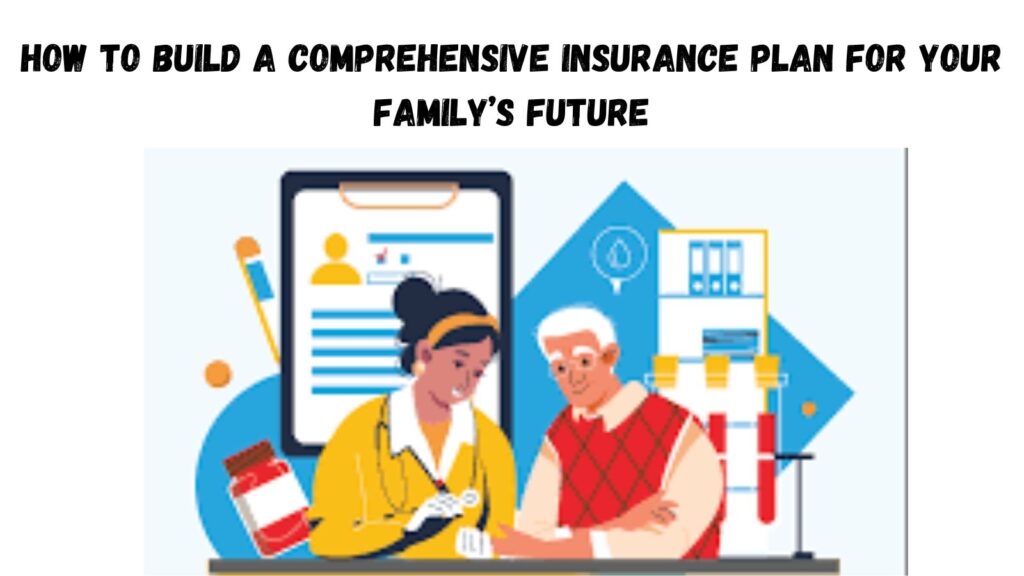In today’s world, ensuring your family’s financial security is more important than ever. Life can be unpredictable, and while we cannot control everything, we can control how well we prepare for potential risks. Insurance is a key financial tool. It keeps your loved ones safe from unexpected events. These can include medical emergencies, accidents, or natural disasters.

A good insurance plan covers many areas of life. It includes health, life, home, and auto. This way, your family can handle any challenges that come your way. But how can you build a comprehensive insurance plan that caters to all your needs and provides peace of mind? Let’s break it down step by step.
Step 1: Assess Your Family’s Needs
Contents
- 1 Step 1: Assess Your Family’s Needs
- 2 Step 2: Choosing the Right Health Insurance
- 3 Step 3: Life Insurance – Protecting Your Family’s Future
- 4 Step 4: Disability Insurance – Safeguarding Your Income
- 5 Step 5: Home Insurance – Protecting Your Home
- 6 Step 6: Auto Insurance – Staying Safe on the Road
- 7 Frequently Asked Questions
Before diving into the details of the different types of insurance, you must first understand your family’s specific needs. Consider factors such as:
- Number of dependents: How many people rely on your income?
- Current health conditions: Does the family have any pre-existing health issues that need special coverage?
- Current debts and liabilities: Do you have mortgages, student loans, or other financial obligations?
- Future goals: Are you planning for college tuition, retirement, or significant life events?
Once you have a clear picture of your family’s needs, you can make informed decisions about which types of insurance are necessary.
Step 2: Choosing the Right Health Insurance
Health insurance is often the first step in securing your family’s future. The National Health Interview Survey shows that almost 30% of Americans under 65 had medical costs they couldn’t pay. This highlights how vital health insurance is.
Types of Health Insurance Plans:
- Employer-sponsored insurance: Many people get health coverage from their job, and it’s usually cheaper.
- Individual health insurance: If you’re self-employed or don’t get insurance from your job, you may need to buy your own.
- Medicare and Medicaid help families with elderly members or low-income individuals by offering important health benefits.
- Health Savings Accounts (HSAs): HSAs allow you to save money tax-free for medical expenses.
Real-Time Example: Meet John, a father of two, who works a 9-to-5 job and receives health insurance from his employer. However, when his wife developed a chronic health condition, their medical bills skyrocketed. They explored supplemental insurance options. This helped them lower out-of-pocket costs and meet their family’s medical needs.
Fun Fact: Did you know that the average American family spends over $20,000 annually on healthcare? That’s a significant portion of the family budget!
Step 3: Life Insurance – Protecting Your Family’s Future
Life insurance is one of the most fundamental forms of protection for your loved ones. It provides financial support to your family in case you pass away unexpectedly. Life insurance can cover:
- Funeral expenses
- Outstanding debts
- Living expenses for dependents
- Education costs for children
Types of Life Insurance:
- Term Life Insurance: Provides coverage for a specific period (usually 10, 20, or 30 years). It’s more affordable but doesn’t accumulate cash value.
- Whole Life Insurance: A permanent policy that lasts for life, offering both a death benefit and a cash value component.
- Universal Life Insurance: It has flexible premiums and benefits. Plus, it includes a cash value accumulation feature.
Real-Time Example: Sarah, a single mother of three, works full-time and has a modest income. After talking with a financial advisor, she chose a term life insurance policy. This way, if anything happened to her, her children would get financial help for their education and daily needs.
Fun Fact: A 30-year-old who doesn’t smoke can get a 20-year life insurance policy for just $20 a month. That’s much less than what many spend on coffee each day!
Step 4: Disability Insurance – Safeguarding Your Income
Imagine being unable to work due to an accident or illness. Disability insurance safeguards your income. It helps your family keep their standard of living when you can’t work.
Types of Disability Insurance:
- Short-Term Disability Insurance: Covers a portion of your salary for a few months.
- Long-Term Disability Insurance: Offers financial support for long periods, typically after short-term coverage ends.
Real-Time Example: Jake, a construction worker, had a serious accident on the job that left him unable to work for six months. His long-term disability insurance helped him pay bills and support his family. This meant he faced no financial stress.
Did you know? The Social Security Administration says 1 in 4 Americans will face a disability before they retire. Protecting your income with disability insurance is essential to avoid financial hardship.
Step 5: Home Insurance – Protecting Your Home
Your home is probably your biggest investment. So, it’s important to protect it from surprises like fire, theft, or natural disasters. Home insurance typically covers:
- Property damage (fire, vandalism, etc.)
- Liability protection (injuries occurring on your property)
- Loss of personal belongings
Types of Home Insurance:
- HO-1: Basic coverage for natural disasters and theft.
- HO-3: This policy offers broad coverage. It protects against most natural disasters, but not floods or earthquakes.
- HO-5: The broadest coverage option, covering all risks except those clearly excluded.
Real-Time Example: In 2020, a wild storm caused significant damage to the Smith family’s home in Texas. Their HO-3 home insurance paid for repairs and replaced lost items, saving them thousands.
Fun Fact: Flood insurance is typically not included in most standard home insurance policies. If you live in a flood-prone area, it’s essential to purchase separate flood coverage!
Step 6: Auto Insurance – Staying Safe on the Road
Auto insurance is mandatory in most states, but it’s also one of the best ways to protect yourself and your family. Whether it’s a car accident, theft, or natural disaster, auto insurance can help cover repairs and medical expenses.
Types of Auto Insurance:
- Liability Insurance: Covers damage to others if you’re at fault in an accident.
- Collision Insurance: Pays for damage to your car after an accident, regardless of who’s at fault.
- Comprehensive Insurance: Covers non-collision-related damages, such as theft or weather-related damage.
- Uninsured/Underinsured Motorist Coverage: Protects you if you’re in an accident with a driver who doesn’t have enough insurance.
Real-Time Example: Emily had a minor accident. Her collision insurance paid for her car repairs. Also, her uninsured motorist coverage covered her medical costs from the other driver’s negligence.
Fun Fact: The average cost of auto insurance in the U.S. is about $1,400 per year. However, by bundling auto insurance with home or life policies, many families can save up to 25% annually.
Step 7: Review and Adjust Regularly
Once your insurance plan is in place, it’s essential to review it periodically. Life circumstances change, and so do insurance needs. Be sure to adjust your coverage if:
- You get a raise or promotion
- You have another child
- You purchase a new home or vehicle
- You experience significant health changes
Conclusion: Building a Secure Future for Your Family
A good insurance plan isn’t just about finding the lowest price. It’s about customizing coverage for your family’s unique needs. By looking at health, life, disability, home, and auto insurance, you build a safety net. This can help your family face financial challenges when they come up. Remember, the key is to assess your needs, research your options, and make sure your insurance plan evolves with your family.
Investing in the right insurance today can safeguard your family’s future tomorrow. Start building a solid insurance plan today. This way, your loved ones stay protected, no matter what happens. Don’t wait until it’s too late!
Cryptocurrency and Insurance: Can Your Digital Assets Be Protected?
Frequently Asked Questions
What is the best type of life insurance for a young family?
For young families, term life insurance is usually the most cost-effective option. It offers strong coverage for a specific time. This keeps your family safe while you raise kids and grow your wealth.
How much home insurance should I have?
Homeowners need enough insurance to cover the full replacement value of their home and belongings. This amount may vary depending on local construction costs, the value of your home, and the extent of coverage.
Do I need disability insurance if I have life insurance?
Yes, disability insurance is essential because life insurance only pays out in the event of death. Disability insurance protects your income if you become unable to work due to illness or injury.
How often should I review my insurance policy?
Review your insurance policy at least once a year. Also, check it when big life events happen, like getting married, having a baby, or buying a new home.
Is auto insurance mandatory in every state?
Yes, auto insurance is required in all states, though the exact minimum coverage requirements can vary by location. Always check the specific rules in your state.
This guide helps you create a personalized insurance plan for your family. It will help you make smart choices to protect your loved ones from unexpected risks.


